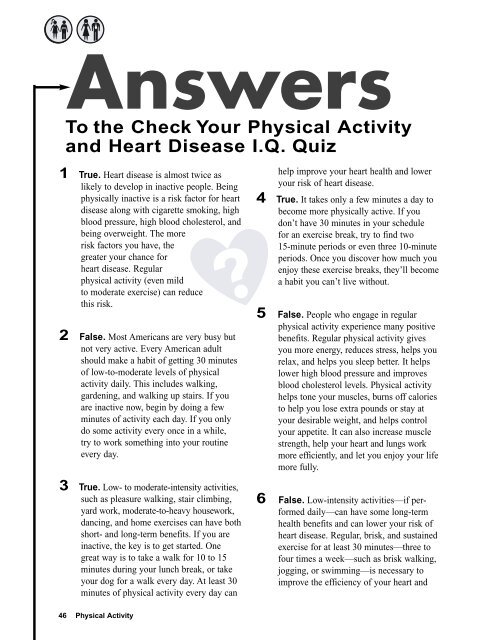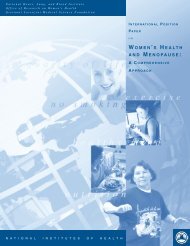HeartsNParks Community Mobilization Guide - National Heart, Lung ...
HeartsNParks Community Mobilization Guide - National Heart, Lung ...
HeartsNParks Community Mobilization Guide - National Heart, Lung ...
Create successful ePaper yourself
Turn your PDF publications into a flip-book with our unique Google optimized e-Paper software.
To the Check Your Physical Activity<br />
and <strong>Heart</strong> Disease I.Q. Quiz<br />
1 True. <strong>Heart</strong> disease is almost twice as<br />
likely to develop in inactive people. Being<br />
physically inactive is a risk factor for heart<br />
disease along with cigarette smoking, high<br />
blood pressure, high blood cholesterol, and<br />
being overweight. The more<br />
risk factors you have, the<br />
greater your chance for<br />
heart disease. Regular<br />
physical activity (even mild<br />
to moderate exercise) can reduce<br />
this risk.<br />
2 False. Most Americans are very busy but<br />
not very active. Every American adult<br />
should make a habit of getting 30 minutes<br />
of low-to-moderate levels of physical<br />
activity daily. This includes walking,<br />
gardening, and walking up stairs. If you<br />
are inactive now, begin by doing a few<br />
minutes of activity each day. If you only<br />
do some activity every once in a while,<br />
try to work something into your routine<br />
every day.<br />
3 True. Low- to moderate-intensity activities,<br />
such as pleasure walking, stair climbing,<br />
yard work, moderate-to-heavy housework,<br />
dancing, and home exercises can have both<br />
short- and long-term benefits. If you are<br />
inactive, the key is to get started. One<br />
great way is to take a walk for 10 to 15<br />
minutes during your lunch break, or take<br />
your dog for a walk every day. At least 30<br />
minutes of physical activity every day can<br />
46 Physical Activity<br />
help improve your heart health and lower<br />
your risk of heart disease.<br />
4 True. It takes only a few minutes a day to<br />
become more physically active. If you<br />
don’t have 30 minutes in your schedule<br />
for an exercise break, try to find two<br />
15-minute periods or even three 10-minute<br />
periods. Once you discover how much you<br />
enjoy these exercise breaks, they’ll become<br />
a habit you can’t live without.<br />
5 False. People who engage in regular<br />
physical activity experience many positive<br />
benefits. Regular physical activity gives<br />
you more energy, reduces stress, helps you<br />
relax, and helps you sleep better. It helps<br />
lower high blood pressure and improves<br />
blood cholesterol levels. Physical activity<br />
helps tone your muscles, burns off calories<br />
to help you lose extra pounds or stay at<br />
your desirable weight, and helps control<br />
your appetite. It can also increase muscle<br />
strength, help your heart and lungs work<br />
more efficiently, and let you enjoy your life<br />
more fully.<br />
6 False. Low-intensity activities—if performed<br />
daily—can have some long-term<br />
health benefits and can lower your risk of<br />
heart disease. Regular, brisk, and sustained<br />
exercise for at least 30 minutes—three to<br />
four times a week—such as brisk walking,<br />
jogging, or swimming—is necessary to<br />
improve the efficiency of your heart and
















